The people of Hong Kong are variously described as being the most business-minded, materialistic, competitive and restless population on the planet. Few other cities have such a complex, unsettled history. It is a place that moves at lightning speed because time is money, and every minute costs. Though it can sometimes infuriate, life in Hong Kong is addictive, and even those who have escaped to more peaceful places – vowing never to return – have been drawn back like iron filings to a magnet. Even the most jaded visitor usually finds something seductive about it.
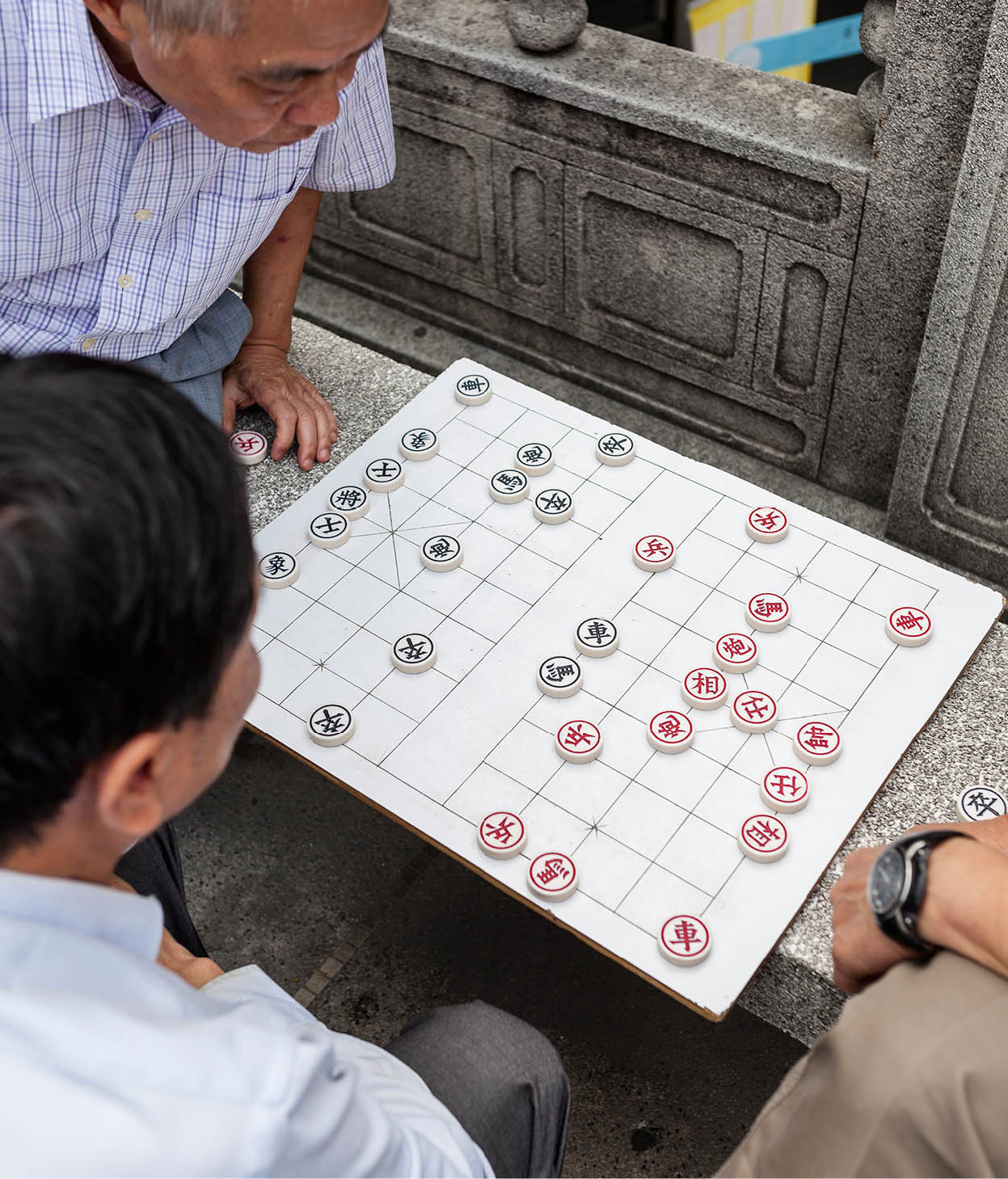
Chinese chess is only vaguely similar to its Western counterpart.
Ming Tang-Evans/Apa Publications
Hong Kong’s 7 million people are packed into just 1,103 sq km (426 sq miles), and certain areas have some of the world’s highest population densities. During rush hour, overwhelming crowds of commuters squeeze themselves into trains and buses. Lunch hour is a feeding frenzy, as thousands of office workers dash for restaurants, jostling and barging their way into tiny noodle shops and delicatessens. Elbowing strangers, jumping queues and honking horns in traffic jams (often complemented by deafening construction sites and roadworks) are unavoidable features of daily life here.
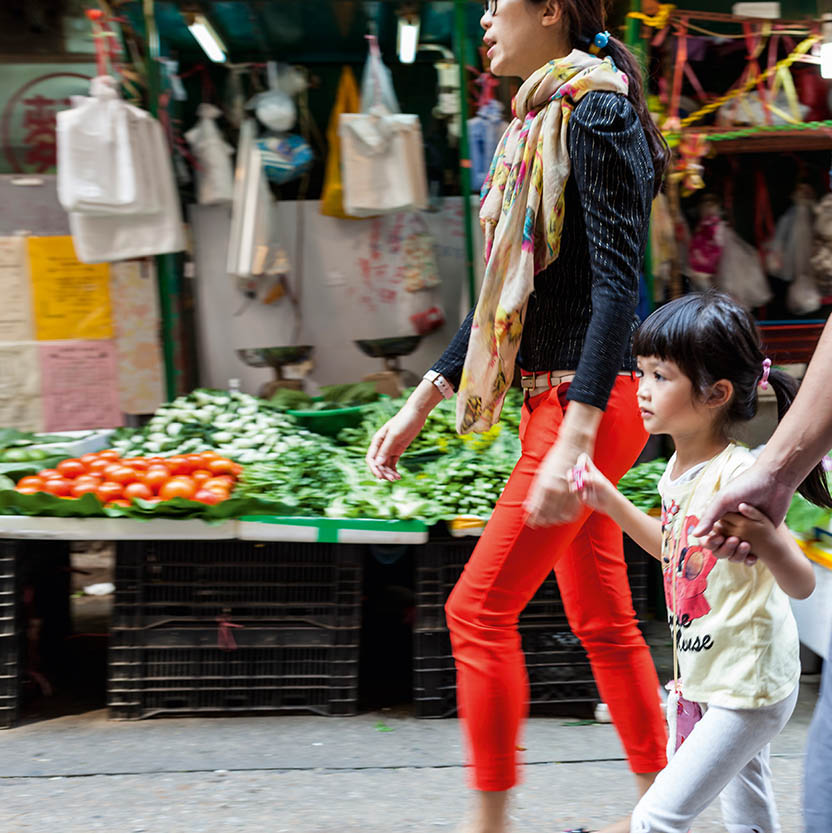
Family shopping at Graham Street Market.
Ming Tang-Evans/APA Publications
As a major trading port situated on the fertile Pearl River Delta, Hong Kong has long been a magnet for immigrants in search of a better life. New arrivals continue to flood in from China and overseas, all sharing one dream: to make money quickly and to enjoy spending it. This continual injection of new blood is part of what gives Hong Kong its excitement and intensity.
For those seeking a settled, peaceful existence, Hong Kong will be a hard slap in the face. This place resounds with rags-to-riches tales of entrepreneurs who built up their business empires from scratch, and this promise of success is in the minds of almost every immigrant who heads here.
Local identity
Hong Kong is, and always has been, Chinese. In spite of more than 150 years of colonial rule, the Chinese, who make up more than 93 percent of the population, never had a sense of allegiance to the British Crown. Those of the older generation, who originated from elsewhere, often identified with their home provinces or towns in China rather than Hong Kong.
On the whole, however, local Chinese are more inclined to view themselves as Hong Kong citizens rather than Han Chinese. This sense of identity has increased in the post-handover years, along with what could be termed an embryonic civic pride – Hong Kongers no longer regard their city simply as somewhere to live and make money, with an eye to moving on somewhere else as needs dictate. Greater political and even environmental awareness – examples include the campaign to halt further reclamation of the harbour – are symptoms of a maturing city growing in confidence and sophistication. It is in part due to the fact that the local population is ever more likely to have been born and raised here, and that they are part of what is likely to become the world’s largest economy within a generation.
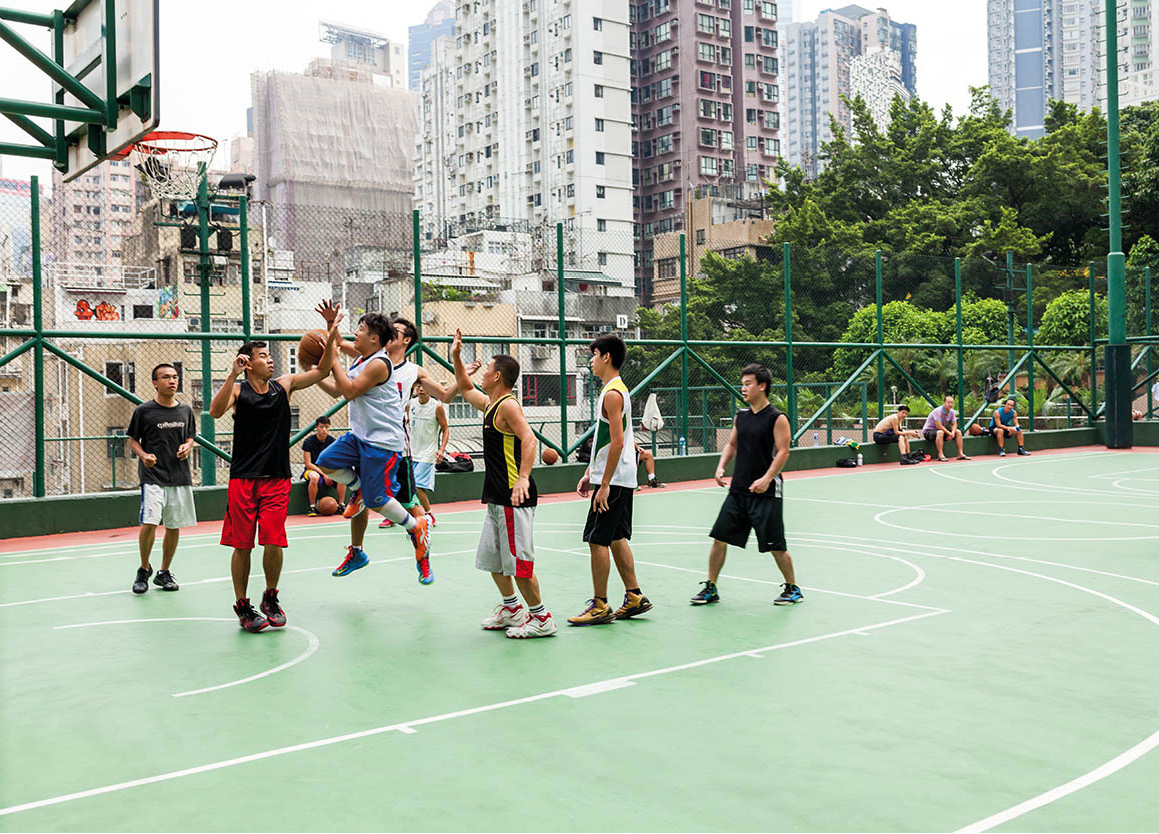
Western sports such as basketball are popular in Hong Kong.
Ming Tang-Evans/APA Publications
Ethnic groups
Hong Kong’s original inhabitants (for more information, click here) settled in what is now the New Territories and outlying islands. Sometimes referred to as the Punti “people of the earth”, they were mainly farmers. In the 13th century, Kublai Khan’s Mongol hordes swept south into China, destroying the Song dynasty and pushing Han Chinese farmers southwards from the mainland into Hong Kong. The Tang clan settled in the fertile Shek Kong Valley, where they established a cluster of walled villages including Kat Hing Wai in Kam Tin (for more information, click here). They were followed over the centuries by various other families, forming the so-called “Five Great Clans”: the Tang, Hau, Pang, Liu and Man. These people developed trade in salt, pearls, ceramics and fishing, and farmed the fertile river valleys.
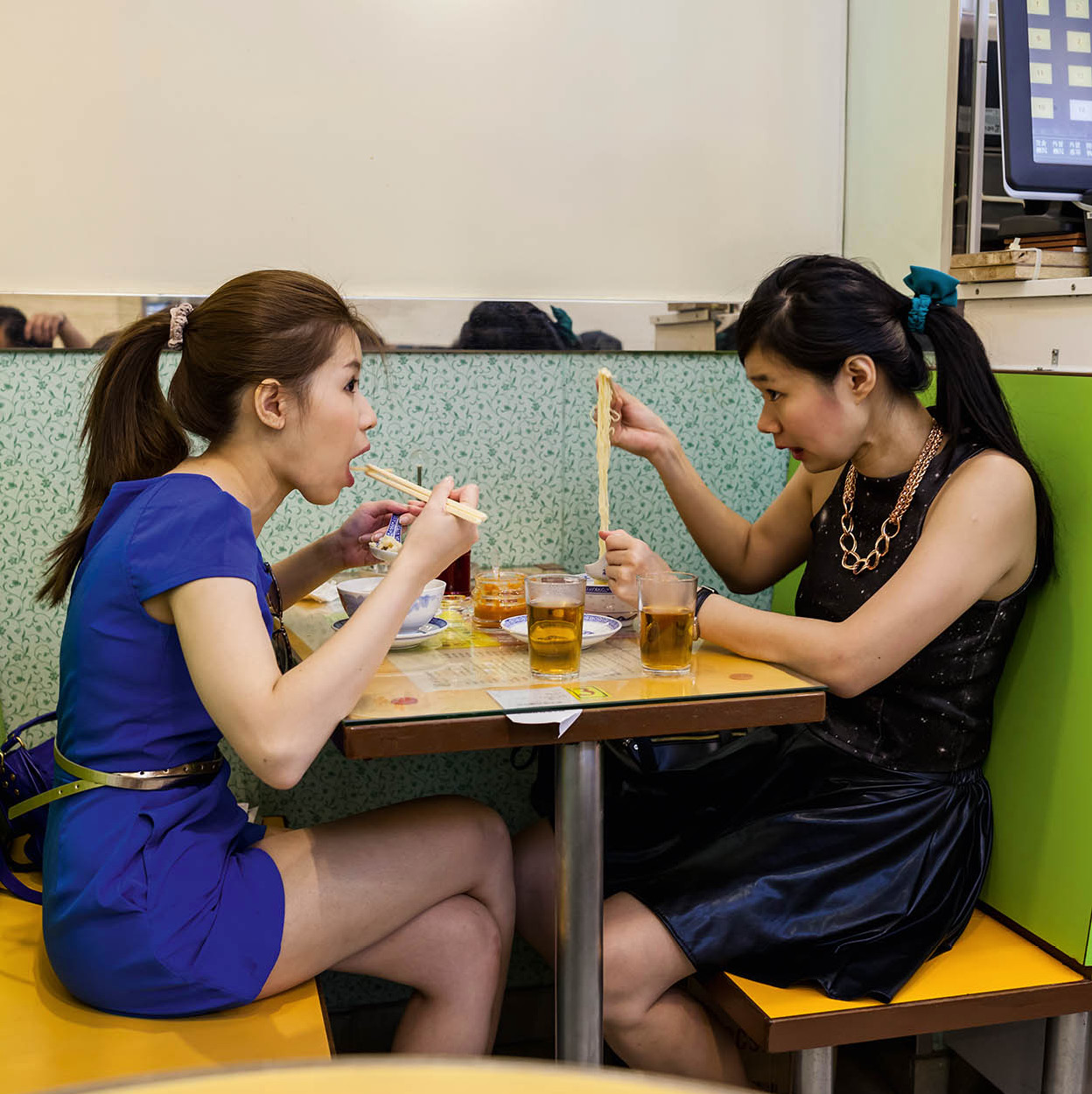
Friends talk over noodles.
Ming Tang-Evans/Apa Publications
Meanwhile, the Hakka (“guest people”) migrated southwards in waves from central China. As later arrivals they made the best of the more hilly land in the eastern New Territories.
For centuries a sprinkling of Tanka “boat people” have lived on junks in places like Tai O and Aberdeen, harvesting pearls and making salt. Legend has it that the Tanka are the descendants of the 5th-century general, Lu Tsun, who revolted against the emperor; after his death, his people were persecuted and deemed unworthy to live on land.

Boarding a tram.
Ming Tang-Evans/Apa Publications
The Tanka’s boat-based communities also attracted the Hoklo people, who originate from the area around Fuzhou (Fujian province) and were traditionally fishermen and manual labourers. Today all fishing communities celebrate the sea goddess Tin Hau’s birthday on the 23rd day of the third moon, sailing in elaborately decorated fishing boats to her temples to pray for protection at sea.
These ethnic groups remained remote from the Chinese, and later British, imperial authorities all the way through to the 1950s
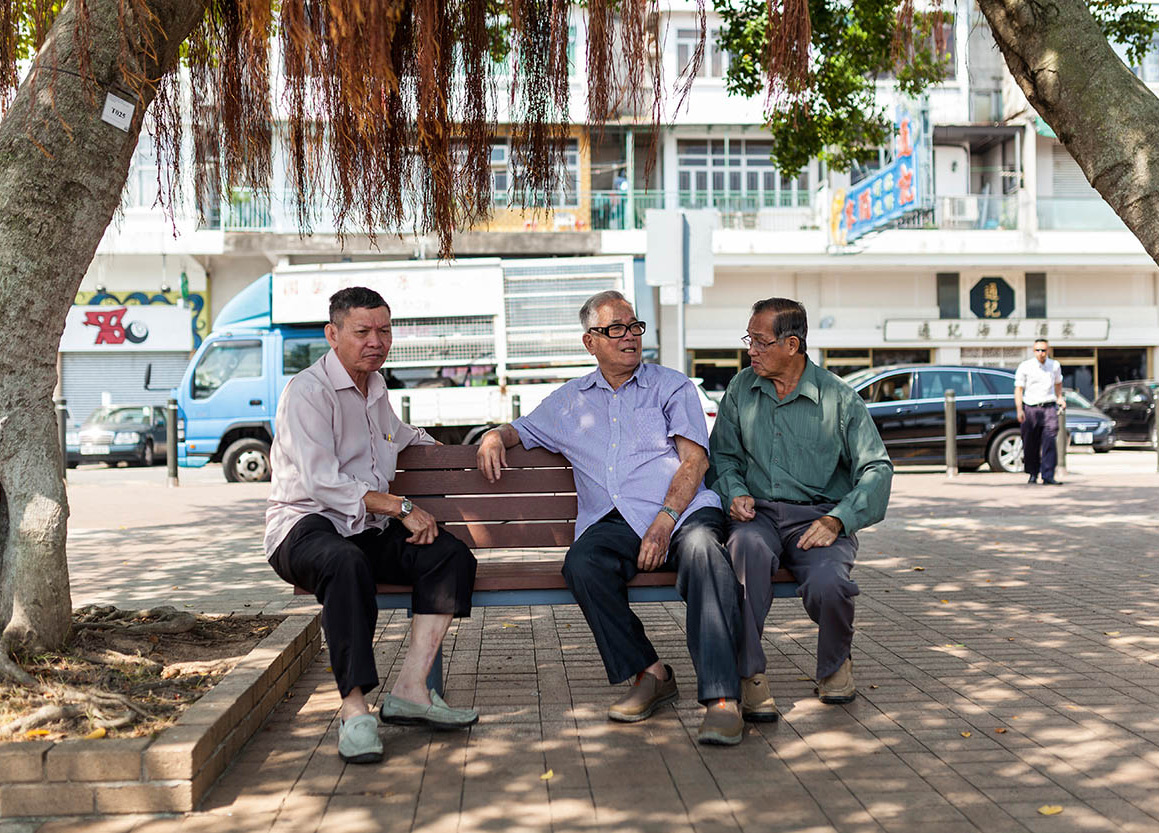
Locals sitting on a bench.
Ming Tang-Evans/Apa Publications
The Cantonese
This mix of “indigenous” people is now comprehensively outnumbered by the Cantonese, who trace their roots back to other areas of Guangdong province. Traditionally regarded as a rebellious, ungovernable people given to spontaneous action if angered, they have always been mistrusted by emperors and regimes. The Nationalist revolution, which toppled the Qing dynasty in 1912, was instigated by a Cantonese, Dr Sun Yat-sen, and Guangzhou became the centre for the Nationalist Party, the first modern political party in China. The Chinese Communist Party founded the Peasant Movement Training Institute, their first school, in Guangzhou in 1922, and Mao Zedong is said to have developed his theory of peasant revolution while working in the city.
For over a hundred years, from the latter part of the 19th century to the present day, the port of Hong Kong has been the destination of migrants, some of whom stayed in the farming villages of the New Territories or the urban centres of Kowloon or Central and Western. Many headed further afield to the US, Australia or Southeast Asia. Never was the push and pull of migration more evident than during and after the Japanese Occupation and following the end of the Chinese Civil War. Arrivals from Guangdong remained the majority, but in the late 1940s large numbers of refugees from Shanghai, the former commercial centre of China, fled to Hong Kong when the communists took over. Many foreign firms also relocated their Chinese headquarters to Hong Kong. The Shanghainese community settled in North Point on Hong Kong Island, and the businessmen among them were quick to use their capital, know-how and pool of labour to set up factories.
The Cantonese language
The Cantonese language often sounds harsh and argumentative to unaccustomed ears, but its humour, slang and interspersed English words make for lively conversation. Cantonese is also centuries older than Mandarin (putonghua), the official language of China, which evolved later in the courts of Mongol emperors during the Yuan dynasty (1271–1368). Therefore, the original rhythms and sounds of classical Tang- and Song-dynasty poetry are probably closer to modern-day Cantonese. On a day-to-day level Cantonese is a bawdy language: quite innocent-looking individuals swear like troopers, and people are often brutal when commenting on other people’s appearance and delight in puns and double entendres.
The Chiu Chow (Shantou) people from further up the Guangdong coast, also renowned for their business acumen, clung together in powerful clan networks, and settled in Sai Ying Pun and Kowloon City.
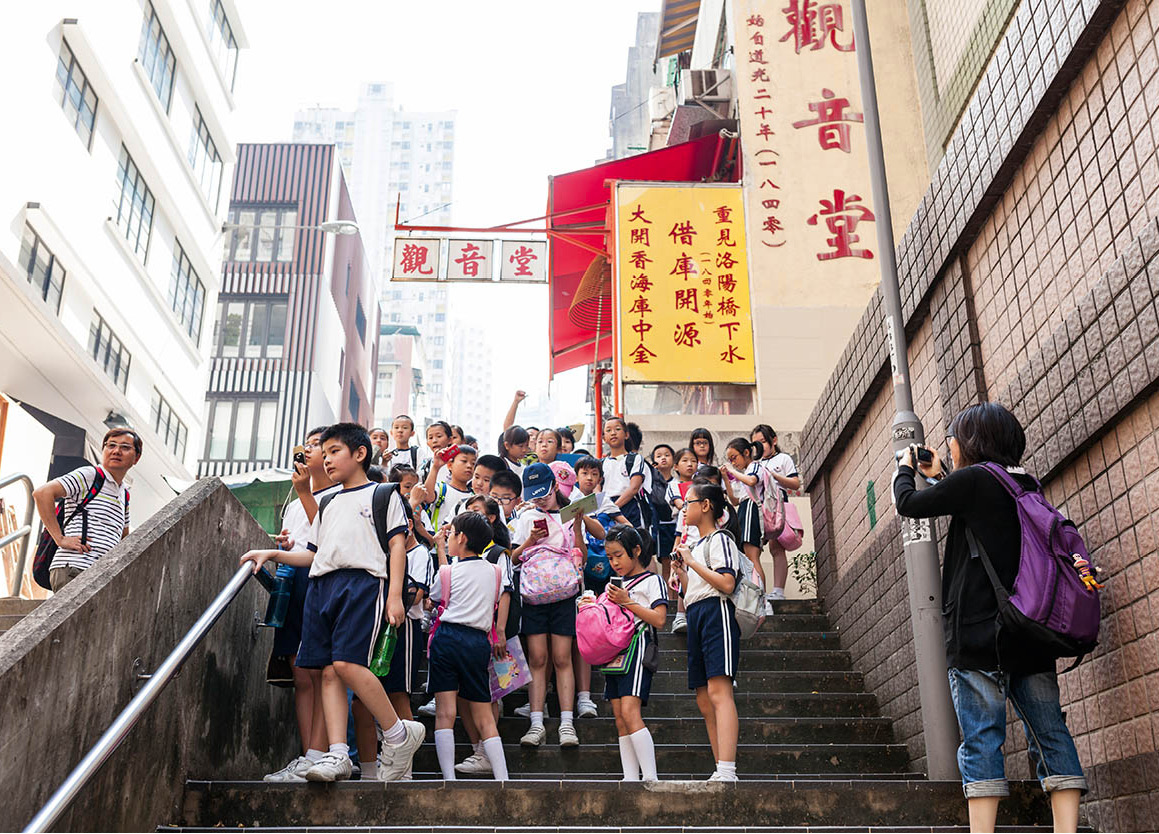
A school outing in PoHo.
Ming Tang-Evans/APA Publications
Population explosion
For much of the 1950s, ’60s and ’70s, illegal immigrants continued to outwit the battalions of the People’s Liberation Army (PLA) and Chinese coastal gunboats, which cooperated with Hong Kong’s security forces. By 1980 this influx, combined with a high birth rate, had pushed Hong Kong’s population to 4 million (for more information, click here).
These decades of population growth coincided with Hong Kong’s rapid industrialisation, a time when factories were desperate for labour. During the early 1950s many people lived in squatter huts, then later in newly built government housing blocks in Kowloon, which preceded the vast New Town developments (today more than half of Hong Kong’s citizens live in New Towns in the New Territories).
Population facts & figures
Hong Kong’s population passed the 7 million mark in 2009 and at the last census, in 2011, stands at 7.07 million. It means that each square kilometre of its territory is home to an average of 6,300 people (16,000 per sq mile) – making it one of the world’s most crowded places. Locally born residents form the majority of the population (60 percent), with 32 percent having been born elsewhere in China. Cantonese is spoken by 96 percent, but 45 percent can speak English and 40 percent Mandarin. There are also over 200,000 speakers each of Hakka, Chiu Chow, Hokkien (Fukien) and Shanghainese. At 82.4 years, life expectancy is the world’s second-highest, while infant mortality rates are among the lowest.
In the New Territories, farming was in decline, unable to provide sufficient employment for the typically large families living there. Throughout the 1950s, the UK’s policy to recruit unskilled workers from its colonies drew thousands of young men from these rural communities. Many of the founders of British Chinese takeaway restaurants were part of this exodus.
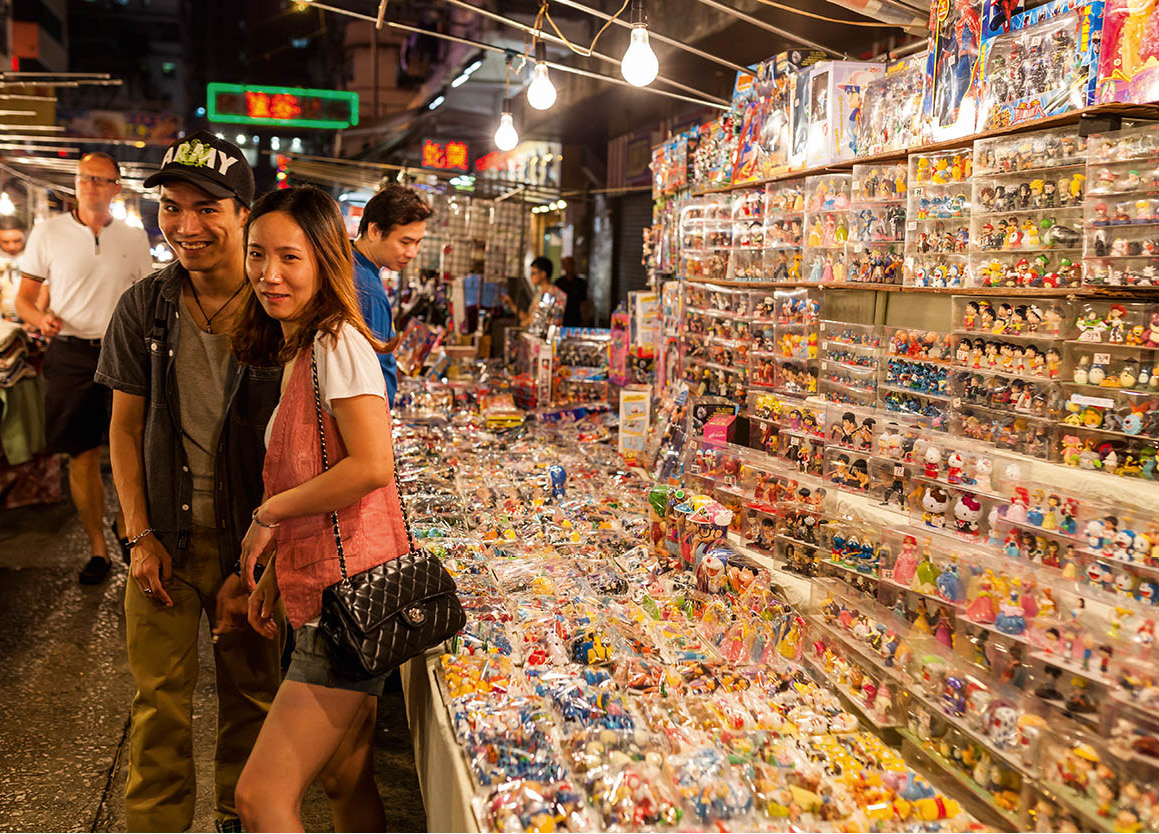
Shopping at the Temple Street Night Market.
Ming Tang-Evans/Apa Publications
The Right of Abode
As China opened up in the 1980s, a growing number of Hong Kong men, typically new migrants, married mainland Chinese women, creating a new social problem of divided families. Dad lived and worked in Hong Kong while Mum and the kids stayed in Guangdong, visiting only occasionally. After 1997 many of these dependent children, now grown up, sought to claim Right of Abode in Hong Kong, causing fierce debate over residency rights. Initially the Hong Kong Court ruled in their favour, but with Hong Kong concerned that this would instantly grant residency to around 300,000 mainland Chinese, the government in Beijing was asked to rule on the matter, and the interpretation of the Right of Abode was subsequently altered.
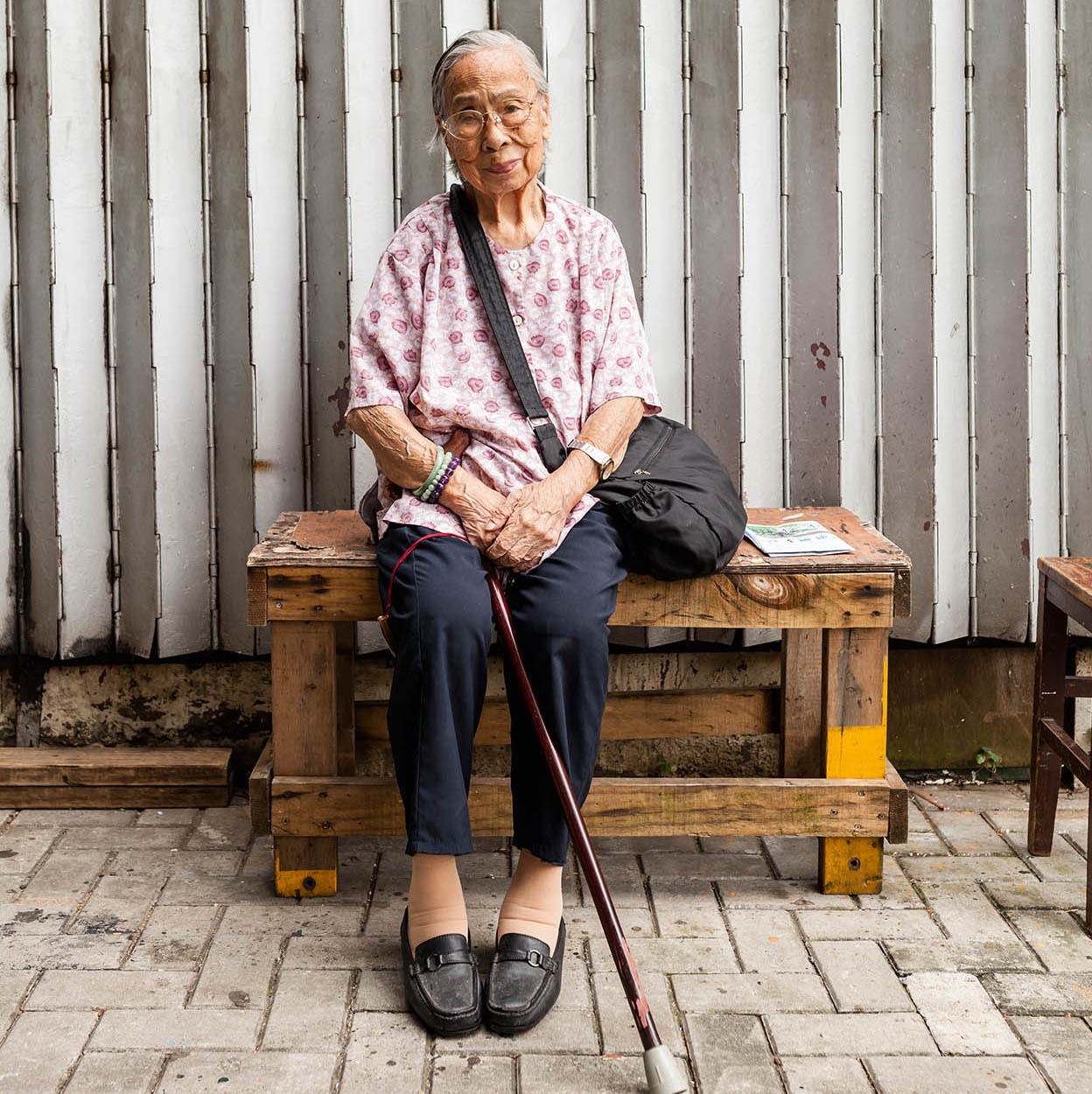
An elderly resident.
Ming Tang-Evans/APA Publications
Since then, anyone from mainland China who is coming to Hong Kong from China to reunite families is given priority in the quota of new arrivals allowed. Nowadays, the number of mainlanders allowed to settle has been increasing – from 25,000 a year in the late 1980s to 54,750, or 150 per day, in 2013. However, tens of thousands of Hong Kong men marry mainland women every year and a 2001 court ruling that anyone born in Hong Kong was entitled to residency led thousands of pregnant mainland women arriving at Hong Kong maternity wards in the advanced stages of labour. This became one of the hot topics around the 2012 legislative elections, with the winning chief executive, Leung Chun-ying, banning mainland mothers from scheduling birthing appointments in 2013. This is one of the primary reasons that resentment against mainlanders still smoulders in parts of Hong Kong society.
Many of these mothers plan to send the children to Hong Kong for schooling, often while mothers, and sometimes fathers too, remain in Guangdong to work; this is creating a new range of social problems and difficulty in adjustment. Today, many new arrivals from the mainland are still derided as ah tsan (country bumpkins) and are the butt of jokes in soap operas, despite the fact that they share the same heritage as most Hong Kong residents.
Dual identity
After the 1984 Sino-British agreement to return Hong Kong to China, and the events in Tiananmen Square in 1989, a new type of migration emerged in the territory. Between 1990 and 1997 some 300,000 are thought to have left Hong Kong, travelling mainly to Canada, Australia and the United States. The price of securing a foreign passport meant sacrificing businesses, family and friends, and starting from scratch in an alien country. Many of the émigrés then returned to Hong Kong after establishing permanent residence overseas, shuttling back and forth annually to retain their status in both places. Many enter the SAR (for more information, click here) and China with their Hong Kong ID card, but use their foreign passport when travelling farther afield.
Expatriates in Hong Kong
Hong Kong’s cultural diversity is largely a result of the many different foreign nationals who have made their home here, either temporarily or permanently. Indeed, the 6 percent of the population that is not Chinese have made valuable contributions to cuisine, arts, culture and religion in Hong Kong, while assimilating local customs and traditions. Hong Kong grants permanent residency and the right to vote (albeit for a limited number of seats in Legco) to all – with the exception of domestic helpers – who have lived here legally for seven years continuously, but only those with Chinese parentage will be granted a Hong Kong SAR passport (see box).
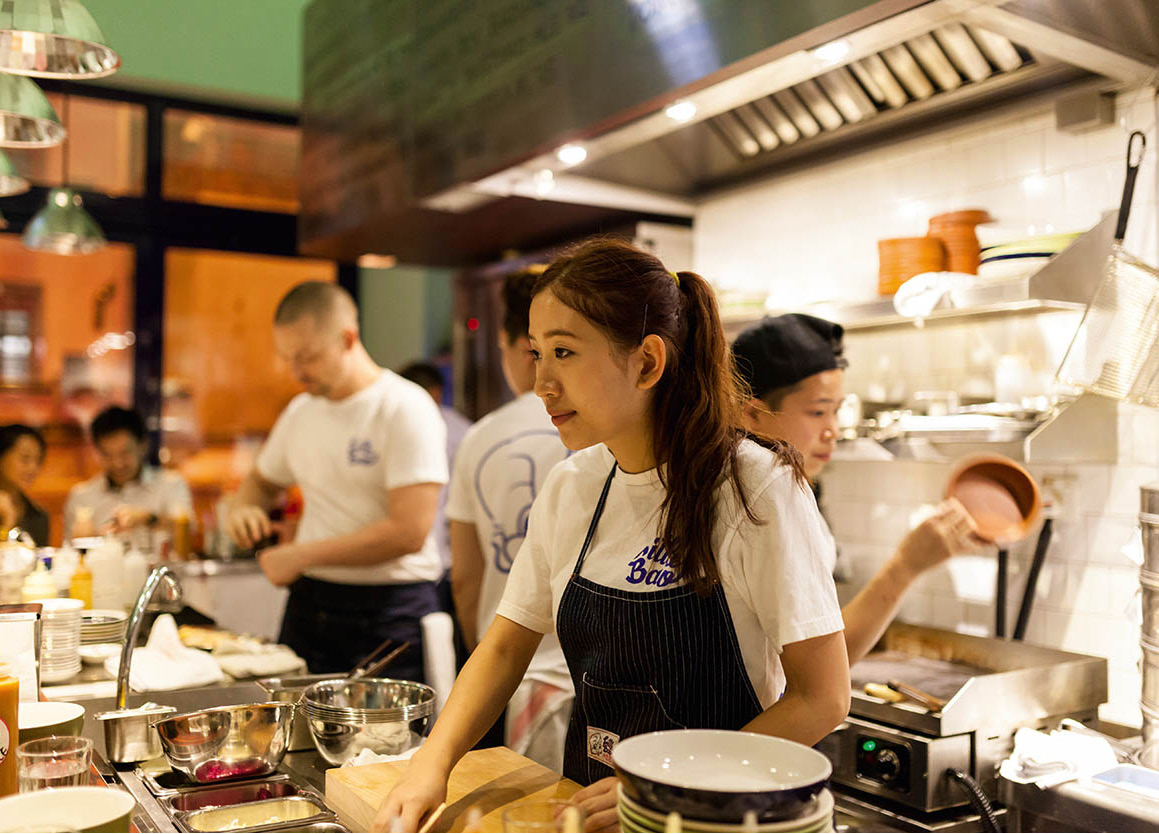
Busy chefs at Little Bao.
Ming Tang-Evans/APA Publications
American, Australian, Canadian, South African, British and other European expatriates – gweilo (“ghost person” or “foreign devil”) as they are known in Cantonese – make up the majority of the foreign business community, numbering around 36,000. (It is worth noting that the term gweilo is in such common use that it is not generally taken to be offensive. However Cantonese slang for people from the mainland, and anyone with a darker skin, is generally derogatory.) During British rule, expatriates were often given preferential treatment in the workplace, commanding much higher salaries than the Chinese. Today, these inequalities are less apparent. Nonetheless, in recent years Hong Kong has tried to focus on attracting skilled professionals through various schemes. It grants working visas to more than 210,000 non-Chinese professionals each year, and has a special scheme targeting mainland professionals.
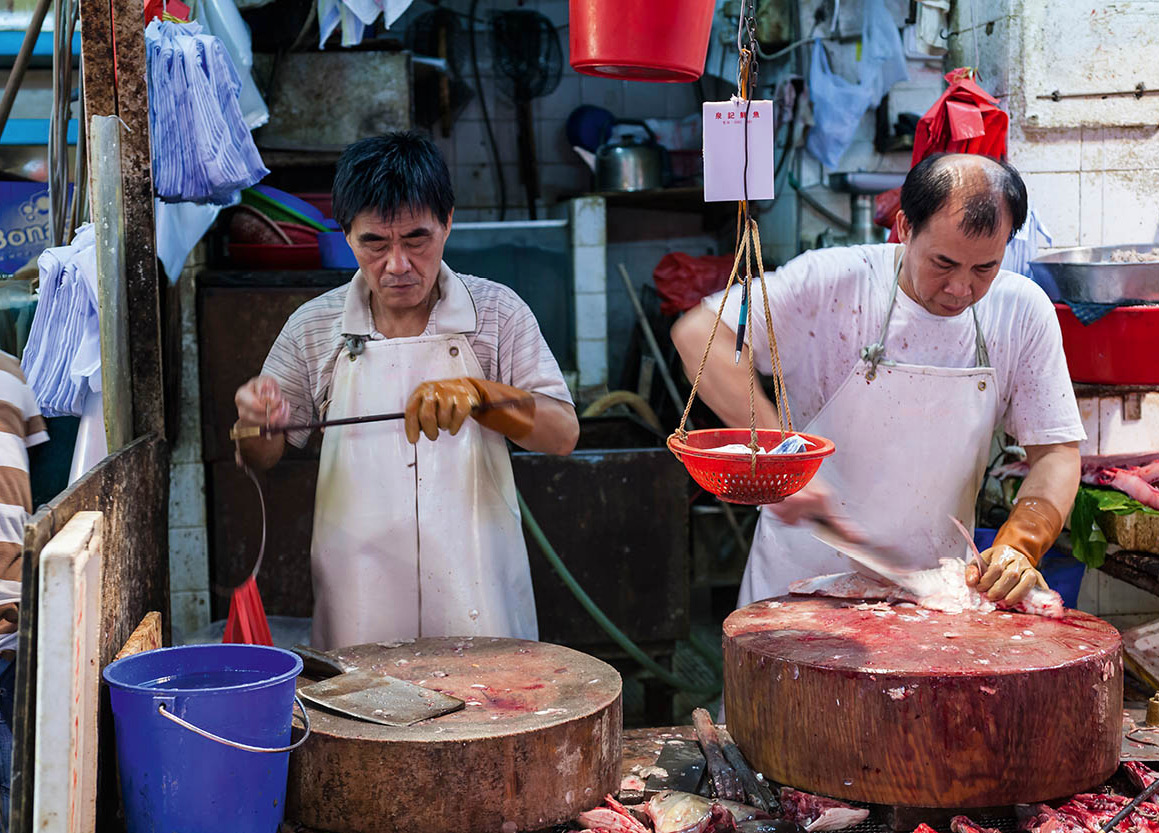
Fresh fish at the market.
Ming Tang-Evans/Apa Publications
There are increasing numbers of Asian expatriates and overseas-born Chinese living as expatriates in Hong Kong. The Japanese business community has played a quiet but important role in commerce in Hong Kong and China, and there are some 2,000 Japanese companies and almost 14,000 Japanese residents in the SAR.
One of the more established foreign communities in Hong Kong comprises the descendants of early merchant traders and soldiers who followed the Union Jack from the Indian subcontinent to Hong Kong: Indians – including many Sikhs and Parsees, as well as Sri Lankans, Pakistanis and Bangladeshis. Their descendants, many of whom speak fluent Cantonese can only be granted HKSAR passports if they can prove Chinese blood or jump through a tough series of hoops. Up to 8,000 were granted British passports in a last-minute ruling in 1996.
A few thousand ex-Gurkha troops, who once served in the British army, are now working as security guards in Hong Kong, and many of their locally born offspring use their right to permanent residency to work in Hong Kong too.
Hong Kong’s largest ethnic groups are Filipina and Indonesian domestic helpers. Over 200,000 each year enter on strict employment visas that stipulate they must live-in with their employers and work six days a week. A minimum monthly wage of HK$4,010 (US$517) is in force. This enables both parents in many Hong Kong families to work full time and care for children and elderly relatives.
Most domestic helpers remit the bulk of their pay home to support their own children through schooling and to provide for their extended families. Come Sundays and public holidays, thousands of Filipina helpers gather in Central to meet friends, while the growing Indonesian community tends to gather near Victoria Park in Causeway Bay.